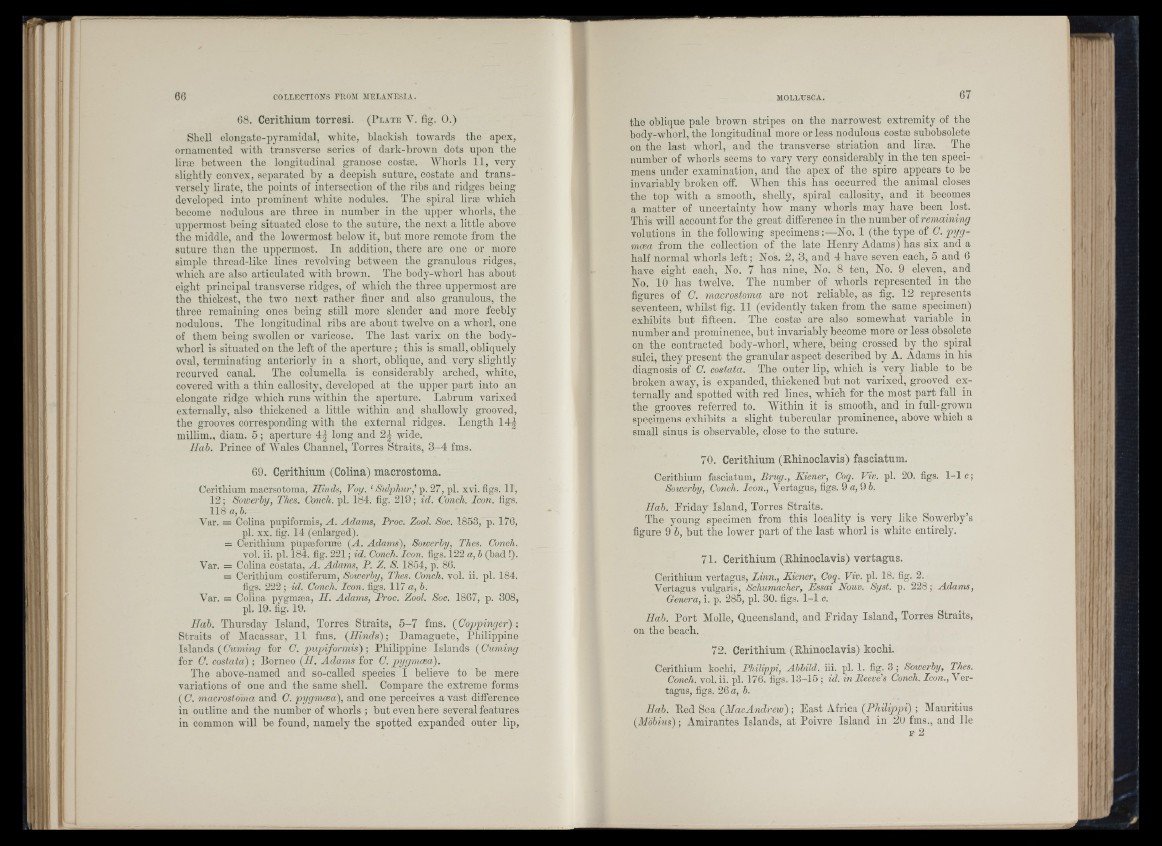
i
à .
06
68. Cerithium torresi. (P late V. fig. 0 .)
Shell elongate-pyramidal, white, blackish towards the apex,
ornamented with transverse scries of dark-brown dots upon the
liræ between the longitudinal granose costæ. Whorls 11, very
slightly convex, separated by a deepish suture, costate and tran sversely
lirate, the points of intersection of the ribs and ridges being
developed into prominent white nodules. The spiral liræ which
become nodulous are three in number in the upper whorls, the
uppermost being situated close to the suture, the next a little above
the middle, and tho lowermost below it, but more remote from the
suture than the uppermost. In addition, there are one or more
simple thread-like lines revolving between tho granulons ridges,
which arc also articulated with brown. The body-whorl has about
eight principal transverse ridges, of which the three uppermost are
the thickest, the two next rather finer and also granulons, the
three remaining ones being still more slender and more feebly
nodulous. The longitudinal ribs are about twelve on a whorl, one
of them being swollen or varicose. The last varix on the bodj^-
whorl is situated on the left of the aperture ; this is small, obliquely
oval, terminating anteriorly in a short, oblique, and very slightly
recurved canal. The columella is considerably arched, white,
covered with a thin callosity, developed at the upper p a rt into an
elongate ridgo which runs within the aperture. Labrum varixed
externally, also thickened a little within and shallowly grooved,
the grooves corresponding with the external ridges,
Length 14¿
millim., diam. 5 ; aperture 4 | long and 2 | wide.
Hab. Prince of AVales Channel, Tori’os Straits, 3 -4 fms.
69. Cerithium (Colina) macrostoma.
Cerithium macrsotoma, Hinds, Voy. ‘Sulphur,’ p. 27, pi. xvi. figs. II,
12 ; Sowerhy, Thes. Conch, pi. 184. fig. 219 ; id. Conch. Icon. figs.
118 a, h.
Var. = Colina pupiformis, A. Adams, Proc. Zool. Soc. 1853, p. 176,
pi. XX. lig. 14 (enlarged).
= Cerithium pupseforme (A. Adams), Sowerhy, Thes. Conch.
vol. ii. pi. 184. fig. 221 ; id. Conch. Icon. figs. 122 a, h (had !).
Var. = Colina costata, A. Adams, P. Z. S. 1854, p. 86.
= Cerithium costiferum, Soiverhy, Thes. Conch, vol. ii. pi. 184.
figs. 222; id. Conch. Icon. figs. 117 a, h.
A’ar. = Colina pj^gmsea, H. Adams, P-oc. Zool. Soc. 1867, p. 308,
pi. 19. tig. 19.
Ilah. Thursday Island, Torres Straits, 5 -7 fms. (Coppinger) ;
Straits of Macassar, 11 fms. {Hinds); Damaguete, Philippine
Islands ( Cuming for C. pupiformis) ; Philippine Islands ( Cuming
for C. costata) ; Borneo ( //. Adams for C. pygnma).
The above-named and so-called species I believe to he mere
variations of one and the same shell. Compare the extreme forms
( C. macrostoma and C. pygmma), and one perceives a vast difference
in outline and the number of whorls ; but even here several features
in common will he found, namely tho spotted expanded outer lip,
tho oblique pale brown stripes on the narrowest extremity of the
body-whorl, the longitudinal more or less nodulous costæ suhohsolete
ou the last whorl, aud the transverse striation and liræ. The
number of whorls seems to vary very considerably in the ten specimens
under examination, and tho apex of the spire appears to be
invariably broken off. AVhen this has occurred the animal closes
the top w'ith a smooth, shelly, spiral callosity, and it becomes
a matter of uncertainty how many whorls may have been lost.
This will account for the great difference in tho number oi remaining
volutions in the following specimens:—No. 1 (the type of C.p yg -
mcea from the collection of the late Henry Adams) has six and a
half normal whorls left; Nos. 2, 3, and 4 have seven each, 5 and 6
have eight each, No. 7 has nine, No. 8 ton. No. 9 eleven, and
No. 10 has twelve. The number of whorls represented in the
figures of C. macrostoma are not reliable, as fig. 12 represents
seventeen, whilst fig. 1 1 (evidently taken from the same specimen)
exhibits but fifteen. The costæ' are also somewhat variable in
number and prominence, but invariably become more or less obsolete
on the contracted body-whorl, where, being crossed by the spiral
sulci, they present the granular aspect described by A. Adams in his
diagnosis of C. costata. The outer lip, which is very liable to be
broken away, is expanded, thickened but not varixed, grooved externally
and spotted with red lines, which for the most part fall in
the grooves referred to. AVithin it is smooth, and in full-grown
specimens exhibits a slight tubercular prominence, above which a
small sinus is observable, close to the suture.
70. Cerithium (Rhiiioclavis) fasciatum.
Cerithium fasciatum, Bnig., Kiener, Coq. Viv. pi. 20. figs. 1-1 c ;
Sowerhy, Conch. Icon., Vertagus, figs. 9 a, 9 b.
Ilah. Friday Island, Torres Straits.
The young specimen from this locality is very like Sowerby’s
figure 9 b, but the lower part of the last whorl is white entirely.
71. Cerithium (Rhinoclavis) vertagus.
Cerithium vertagus, Linn., Kiener, Coq. Viv. pi. 18. fig. 2.
Vertagus vulgaris, Schumacher, Essai Kouv. Syst. p. 228; Adams,
Genera, i. p. 285, pi. 30. figs. 1-1 c.
Hah. Port Molle, Queensland, and Friday Island, Torres Straits,
on the beach.
72. Cerithium (Rhinoclavis) kochi.
Cerithium kochi, Philipqn, Abbild. iii. pi. 1. fig. 3 ; Sowerby, Thes.
Conch, vol. ii. pi. 176. figs. 13-15 ; id. in Reeve’s Conch. Icon., Vertagus,
figs. 26«, b.
Hah. Red Sea {MacAndrew) ; East Africa {Pliilipipi) ; Mauritius
{Mbbius); Amirautés Islands, at Poivre Island in 20 fms., and He
F 2
I. I
'■ i'l
Ii
\ '■ I
. -,. f
i ;
‘ it?f
i I -
il'i f
liri
ill 1